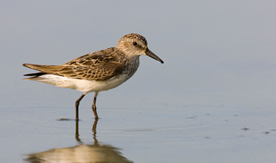
UMaine, MDIF&W Track Semipalmated Sandpipers’ Migration
Saturday, Sept. 6 is World Shorebirds’ Day — a time to celebrate “fantastic migrants.” For biologists Rebecca Holberton and Lindsay Tudor, nearly every day is World Shorebirds’ Day.
They’re in the midst of a two-year study of one of those fantastic migrants — the semipalmated sandpipers (Calidris pusilla). Named for the short webs between their toes, the small sandpipers scurry synchronously on black stilt-like legs, “cherking” and searching for food on the shore.
This year, like last, Holberton, a professor at the University of Maine, and Tudor, a wildlife biologist with the Maine Department of Inland Fisheries and Wildlife (MDIF&W), are conducting health assessments and placing “nano tags” — or very small VHF radio transmitters — on sandpipers.
By monitoring the semipalmated sandpipers’ movements, the scientists learn more about the birds’ stay on the Maine coast during their migration from the Arctic to South America.
In 2013, the first year of the study, Holberton, Tudor and UMaine graduate student Sean Rune learned that during the sandpipers’ stopover in Down East, Maine, they moved between feeding sites along upper Pleasant River, upper Harrington River and Flat Bay during low tide and roosted on offshore ledges at high tide.
Hatching-year birds ate and rested an average of 17.5 days in Maine and adults stayed an average of 12.4 days. Adult semipalmated sandpipers weighed, on average, 5 grams more than hatching-year birds on their first migration.
The young sandpipers, on their first migration and new to this area, may have needed more time to gain enough weight for the energy reserves they needed to fly nonstop to their wintering grounds, Holberton says.
Tudor says it’s easy to be a fan of the little balls of fluff that nearly double their body weight to a hefty 1.4 ounces while resting and refueling during their two- to three-week time in Maine.
When the peeps have packed on sufficient weight, they soar 10,000 to 15,000 feet above the Maine coastline to head out over the ocean and catch a good tail wind. If all goes well, they’ll arrive in South America two to four days later.
One of the species’ many talents — in addition to making their way back to their exact same wintering site each season — is the ability to break down lipids in their fat-filled fuel tank under the skin to power their nonstop 3,000-mile journey over the Atlantic Ocean.
Sandpipers don’t put down in the ocean as they can’t tolerate the cold water, says Tudor, which makes their stay on the Maine coast critical to a successful final leg of their uninterrupted migratory flight to South America.
“When in Maine, they’re our (the public) responsibility, our birds,” Tudor says.” We want to know if the habitat (in Maine) is meeting the birds’ needs.”
Studies indicate that since the 1970s the number of these feathered vertebrates has plummeted 80 percent in North America, Tudor says.
The population decline isn’t exclusive to semipalmated sandpipers. Globally, one in eight, or more than 1,300 bird species, are threatened with extinction, according to BirdLife International as reported in National Geographic.
This project increases the researchers’ knowledge about reasons for the nosedive in numbers of semipalmated sandpipers and points to which of its life stages are most perilous.
Semipalmated sandpipers face a variety of challenges, Holberton and Tudor say, including climate change in the Arctic where they breed, loss of coastal habitat along their migration route, and being the target of hunters on the coast of South America where they winter.
The 5-to-6-inch-tall birds are opportunists that feed on intertidal invertebrates at the interface of land and sea. Thus, they’re an indicator species for the health of mudflats as well as sentinels for the natural world in general, Holberton says.
“The Gulf of Maine ecosystem is really facing challenges,” Holberton says. “We share resources and if birds are in trouble then so are we. This is another piece of the puzzle.”
The research, funded by Maine Outdoor Heritage Fund, Eastern Maine Conservation Initiative, Maine Agricultural and Forest Experiment Station, and U.S. Fish & Wildlife Service, utilizes 50 automated VHF telemetry receiver towers that range from the Bay of Fundy to Cape Cod.
The nano tags and towers enable the scientists to track the birds when they arrive in Maine and when they leave. Data is fed into a repository coordinated by Phil Taylor at Acadia University.
Tudor and Holberton are pleased the semipalmated sandpipers’ project has expanded; this summer, the U.S. Fish & Wildlife Service is conducting similar research at the Rachel Carson National Wildlife Refuge in Wells. Comparing the data from Down East with data from southern Maine will be interesting and insightful, says Tudor.
The MDIF&W reviews permits for shoreland development and makes recommendations for conservation management plans for high-value habitats. Tudor says it’s important to know if the initiatives are working and whether birds’ needs are being met.
Using binoculars to watch migrating sandpipers and other shorebirds is a great way to celebrate World Shorebirds’ Day, say the scientists; it’s important for people, and dogs, to give them space so they can eat and rest for their upcoming journey.
Tudor and Holberton encourage bird enthusiasts to participate in bird counts and to contact their local Audubon Society for suggestions on ways to assist birds. Holberton invites bird watchers to like the Gulf of Maine Birdwatch page on Facebook.
Contact: Beth Staples: 207.581.3777
